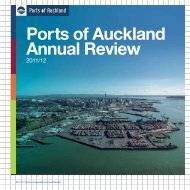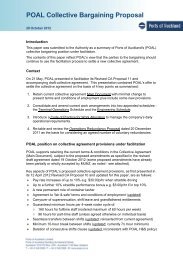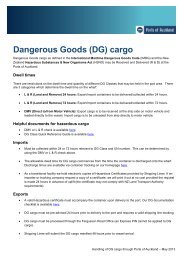Download Financial Statements - Ports of Auckland
Download Financial Statements - Ports of Auckland
Download Financial Statements - Ports of Auckland
You also want an ePaper? Increase the reach of your titles
YUMPU automatically turns print PDFs into web optimized ePapers that Google loves.
<strong>Ports</strong> <strong>of</strong> <strong>Auckland</strong> Limited & Subsidiaries financial report 09<br />
NOTES TO THE FINANCIAL STATEMENTS (continued)<br />
30 June 2009<br />
2 Summary <strong>of</strong> significant accounting policies (continued)<br />
(ii) Associates<br />
Associates are all entities over which the company has significant influence but not control, generally evidenced by holdings <strong>of</strong> between<br />
20% and 50% <strong>of</strong> the voting rights. Investments in associates are accounted for in the parent entity financial statements using the cost<br />
method and in the consolidated financial statements using the equity method <strong>of</strong> accounting, after initially being recognised at cost. The<br />
Group’s investment in associates includes goodwill identified on acquisition (refer to note 37).<br />
The Group’s share <strong>of</strong> its associates’ post-acquisition pr<strong>of</strong>its or losses is recognised in the income statement, and its share <strong>of</strong> postacquisition<br />
movements in reserves is recognised in reserves. The cumulative post-acquisition movements adjust the carrying amount <strong>of</strong><br />
the investment. Dividends receivable from associates are recognised in the parent entity’s income statement, while in the consolidated<br />
financial statements they reduce the carrying amount <strong>of</strong> the investment.<br />
When the Group’s share <strong>of</strong> losses in an associate equals or exceeds its interest in the associate, including any other unsecured<br />
receivables, the Group does not recognise further losses, unless it has incurred obligations or made payments on behalf <strong>of</strong> the associate.<br />
Unrealised gains on transactions between the Group and its associates are eliminated to the extent <strong>of</strong> the Group’s interest in the<br />
associates. Unrealised losses are also eliminated unless the transaction provides evidence <strong>of</strong> an impairment <strong>of</strong> the asset transferred.<br />
Accounting policies <strong>of</strong> associates have been changed where necessary to ensure consistency with the policies adopted by the Group.<br />
(iii) Joint ventures<br />
Jointly controlled entities<br />
The interest in a jointly controlled entity is accounted for in the consolidated financial statements using the equity method and is carried<br />
at cost by the parent entity. Under the equity method, the share <strong>of</strong> the pr<strong>of</strong>its or losses <strong>of</strong> the jointly controlled entity is recognised in the<br />
income statement, and the share <strong>of</strong> movements in reserves is recognised in reserves in the balance sheet.<br />
When the Group’s share <strong>of</strong> losses in a jointly controlled entity equals or exceeds its interest in the jointly owned entity, including any other<br />
unsecured receivables, the Group does not recognise further losses, unless it has incurred obligations or made payments on behalf <strong>of</strong> the<br />
jointly owned entity.<br />
Unrealised gains on transactions between the Group and its jointly controlled entity are eliminated to the extent <strong>of</strong> the Group’s interest in<br />
the jointly controlled entity. Unrealised losses are also eliminated unless the transaction provides evidence <strong>of</strong> an impairment <strong>of</strong> the asset<br />
transferred. Accounting policies <strong>of</strong> jointly controlled entities have been changed where necessary to ensure consistency with the policies<br />
adopted by the Group.<br />
(c) Segment reporting<br />
A business segment is a group <strong>of</strong> assets and operations engaged in providing products or services that are subject to risks and returns<br />
that are different to those <strong>of</strong> other business segments. A geographical segment is engaged in providing products or services within a<br />
particular economic environment and is subject to risks and returns that are different from those <strong>of</strong> segments operating in other<br />
economic environments.<br />
(d) Foreign currency translation<br />
(i) Functional and presentation currency<br />
Items included in the financial statements <strong>of</strong> each <strong>of</strong> the Group’s entities are measured using the currency <strong>of</strong> the primary economic<br />
environment in which the entity operates (‘the functional currency’). The financial statements are presented in New Zealand dollars, which<br />
is the Group’s functional and presentation currency.<br />
(ii) Transactions and balances<br />
Foreign currency transactions are translated into the functional currency using the exchange rates prevailing at the dates <strong>of</strong> the<br />
transactions. Foreign exchange gains and losses resulting from the settlement <strong>of</strong> such transactions and from the translation at year-end<br />
exchange rates <strong>of</strong> monetary assets and liabilities denominated in foreign currencies are recognised in the income statement, except when<br />
deferred in equity as qualifying cash flow hedges.<br />
(e) Revenue recognition<br />
Revenue comprises the fair value for the sale <strong>of</strong> goods and services, excluding goods and services tax, rebates and discounts and after<br />
eliminating sales within the Group. Revenue is recognised as follows:<br />
(i) Sales <strong>of</strong> services<br />
Sales <strong>of</strong> services are recognised in the accounting period in which the services are rendered, by reference to completion <strong>of</strong> the specific<br />
transaction assessed on the basis <strong>of</strong> the actual service provided as a proportion <strong>of</strong> the total services to be provided.<br />
(ii) Interest income<br />
Interest income is recognised on a time-proportion basis using the effective interest method.

















